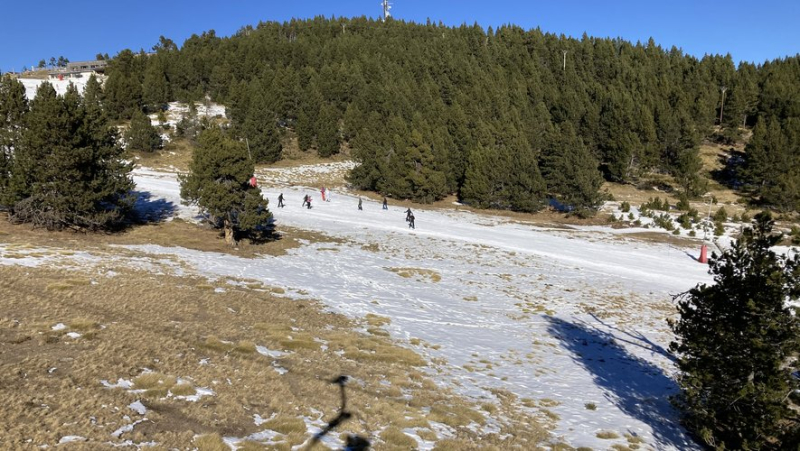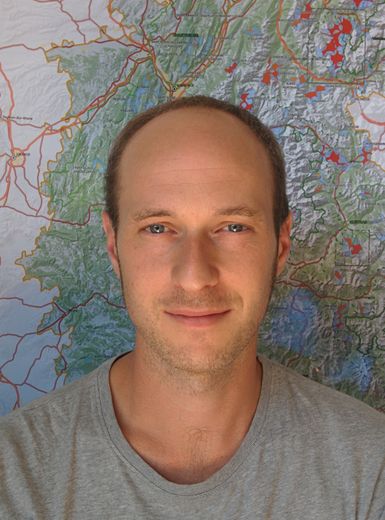“Investing too much in snow can lead to a breaking point”: ski resorts facing climate change

Le 27 décembre, dans la station de ski des Angles (Pyrénées-Orientales). PHOTO S.G.
Can the production of artificial snow be a response to climate change ? For a month, it has allowed ski resorts in the Pyrenees to operate. Hugues François, researcher at Inrae, is co-author of a study by a Franco-Austrian team with Inrae and Météo-France on the snow cover from 2,234 European stations, published in August 2023 in the scientific journal Nature Climate Change.
According to a study by a Franco-Austrian team published on August 28 in the scientific journal Nature Climate Change, without snow production, 53% of European ski resorts risk a severe lack of snow in the prospect of global warming of +2°C. In the Pyrenees, 89% of stations are affected. At + 4°C, a disaster scenario is emerging: 98% of resorts are exposed to a risk of low snowfall. Researcher at Inrae, Hugues François, one of the co-authors of the study, deciphers the issues.

"The need for snow is increasing, but production capacity is decreasing. Be careful of the scissors effect, warns scientist Hugues François. DR
One in two winter sports resorts will be impacted by climate change in a +2°C scenario, and 89% in the Pyrenees. .. these are the actors of the mountain who challenged you to project themselves into an uncertain future ?
We have been working on the subject for around ten years, in a research dynamic born from the proximity of Météo France and Inrae, in Grenoble: "You work on ski resorts , we on the snow. There is a phenomenon called climate change, my colleague Samuel Morin from Météo France asked me. The analysis tools were sufficiently mature to tackle the issue, with the IPCC scenarios. The rereadings imposed by the scientific journal Nature Climate Change have led us to go much further than we imagined on the subject.
We are now able to trace, for a station, the evolution of snow conditions over time.
The stations can ask you ?
With the Dianeige design office, we developed a climate service to put our snow modeling tools within the reach of decision-makers called Climsnow, used today in two French resorts on three. Snow cover is just one of a set of complex parameters that make it possible to establish expertise on a case-by-case basis. But there are sometimes unilateral interpretations which rely more on a priori conceptions than on the results as such.
Winter sports resorts have long been in denial, little helped by scientific work which has long revolved around the question of natural snow. They sometimes cultivate great ambiguity, and tend to have a soothing speech. The interest of this type of tool is to open the debate.
The question is therefore not limited to the production, or not, of artificial snow but questions more generally the future of territories which have a ski resort …
As for snow, today, we produce 70% to 90% of the snow before the season, without knowing how much will fall naturally. But with global warming, the production period will shift in time, which raises questions for the economic model of the stations. Will they still be able to open at Christmas ? On the one hand, the need increases, on the other, production capacity decreases, because it is also sensitive to ;#39;rising temperatures, it is also limited by the availability of water resources.
Ultimately, very contrasting pictures emerge depending on the territory, both because the impacts of climate change are more or less marked, more or less rapid and with response capacities that are not the same. Water resources are a critical factor and their availability varies greatly depending in particular on the nature of the soil and the local precipitation regime. In the Pyrenees, there is a particular relationship between municipalities and water resources, with many stations being close to hydroelectric reservoirs.
Our aim is not necessarily to have a unilateral vision to stop thinking about skiing but to adapt according to each territorial situation. This is a real change of perspective compared to the 1960s, when the development of ski areas was not discussed and was the solution to the problems of economic and social development of mountain areas. At each station, imagine the next one that corresponds to it. Today, securing snow cover in ski areas can contribute to the transition of territories that have a ski resort, but it must be linked to the evolution of economic margins which can be removed from skiing in a context of deteriorating exploitation.
"Scientific work is beginning to be consolidated, we are being tested by reality"
Environmental associations are warning about the conversion into “Four Seasons” activities, which are bringing ever more people to the mountains…< /p>
Through skiing and the precariousness of snow resources, we can question the dependence of the mountains on tourism. The carbon footprint of snow production remains under control, but we cannot dissociate this issue from the movement of people and the stay of tourists. If there is diversification, the economic model remains based on mobility, and extending mobility over four seasons raises questions in terms of carbon footprint, in economic terms too. Perhaps tomorrow this will no longer be possible given the cost of mobility. Finally, tourism "Four seasons" further increases dependence on tourism.
Beyond the speeches, do you have the feeling that elected officials and station directors are listening and aware of the problems ?
If people are initially rather virulent and worried, our tools allow an argumentative discourse, neither incriminating nor exculpatory, including for major developments such as the need to close part of the domain. There is an awareness. But it’s complicated to be confronted with a negative situation when we have no control over it, we are in the fantasy.
We are still in a time where skiing and winter sports bring income to a region. The question is what we do if we consolidate this situation to invest in snow production, with the risk of dependence. If you invest too much in the snow, you can reach a breaking point; the longer you wait, the tighter the turn you have to take if you want to avoid going off the road.
Would you say that we are at a pivotal period ?
We are in a period where we are testing the economic limits of a system. The disruptions in the snow industry invite us to rethink, in a more global way, how we want to live and live in the mountains, the pact between mountain areas and the Nation.
As scientific work begins to be consolidated, we are being tested by reality.
I subscribe to read more




